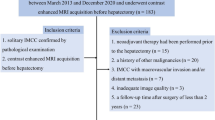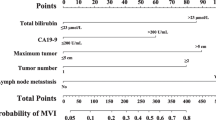Abstract
Purpose
The aim of this retrospective study was to develop and validate a preoperative nomogram for predicting microvascular invasion (MVI) in patients with intrahepatic mass-forming cholangiocarcinoma (IMCC) based on magnetic resonance imaging (MRI).
Methods
In this retrospective study, 224 consecutive patients with clinicopathologically confirmed IMCC were enrolled. Patients whose data were collected from February 2010 to December 2020 were randomly divided into the training (131 patients) and internal validation (51 patients) datasets. The data from January 2021 to November 2021 (42 patients) were allocated to the time-independent validation dataset. Univariate and multivariate forward logistic regression analyses were used to identify preoperative MRI features that were significantly related to MVI, which were then used to develop the nomogram. We used the area under the receiver operating characteristic curve (AUC) and calibration curve to evaluate the performance of the nomogram.
Results
Interobserver agreement of MRI qualitative features was good to excellent, with κ values of 0.613–0.882. Multivariate analyses indicated that the following variables were independent predictors of MVI: multiple tumours (odds ratio [OR]) = 4.819, 95% confidence interval [CI] 1.562–14.864, P = 0.006), ill-defined margin (OR = 6.922, 95% CI 2.883–16.633, P < 0.001), and carbohydrate antigen 19–9 (CA 19–9) > 37 U/ml (OR = 2.890, 95% CI 1.211–6.897, P = 0.017). A nomogram incorporating these factors was established using well-fitted calibration curves. The nomogram showed good diagnostic efficacy for MVI, with AUC values of 0.838, 0.819, and 0.874 for the training, internal validation, and time-independent validation datasets, respectively.
Conclusion
A nomogram constructed using independent factors, namely the presence of multiple tumours, ill-defined margins, and CA 19–9 > 37 U/ml could predict the presence of MVI. This can facilitate personalised therapeutic strategy and clinical management in patients with IMCC.




Similar content being viewed by others
Abbreviations
- ADC:
-
Apparent diffusion coefficient
- AP:
-
Arterial phase
- AUC:
-
Area under the curve
- CA 19–9:
-
Carbohydrate antigen 19–9
- CE:
-
Contrast-enhanced
- DP:
-
Delayed phase
- DWI:
-
Diffusion-weighted imaging
- ECA:
-
Extracellular contrast agent
- EMT:
-
Epithelial-mesenchymal transition
- Gd-EOB-DTPA:
-
Gadolinium ethoxybenzyl diethylenetriamine penta-acetic acid
- Gd-DTPA:
-
Gadolinium diethylene triamine penta-acetic acid
- HBA:
-
Hepatobiliary agent
- HCC:
-
Hepatocellular carcinoma
- ICC:
-
Intrahepatic cholangiocarcinoma
- IMCC:
-
Intrahepatic mass-forming cholangiocarcinoma
- MVI:
-
Microvascular invasion
- NPV:
-
Negative predictive value
- PPV:
-
Positive predictive value
- PVP:
-
Portal venous phase
- ROC:
-
Receiver operating characteristic
- T1W IP-OP:
-
T1-weighted in-phase and out-phase
- T2W-FS:
-
T2-weighted fat-suppressed
- TP:
-
Transitional phase
References
Endo I, Gonen M, Yopp A C, et al. (2008) Intrahepatic cholangiocarcinoma: rising frequency, improved survival, and determinants of outcome after resection. Ann Surg 248(1):84-96.DOI: https://doi.org/10.1097/SLA.0b013e318176c4d3.
Minicozzi P, Cassetti T, Vener C, and Sant M (2018) Analysis of incidence, mortality and survival for pancreatic and biliary tract cancers across Europe, with assessment of influence of revised European age standardisation on estimates. Cancer Epidemiol 55:52-60.DOI: https://doi.org/10.1016/j.canep.2018.04.011.
Lim J H (2003) Cholangiocarcinoma: morphologic classification according to growth pattern and imaging findings. AJR Am J Roentgenol 181(3):819-27.DOI: https://doi.org/10.2214/ajr.181.3.1810819.
Dhanasekaran R, Hemming A W, Zendejas I, et al. (2013) Treatment outcomes and prognostic factors of intrahepatic cholangiocarcinoma. Oncol Rep 29(4):1259-67.DOI: https://doi.org/10.3892/or.2013.2290.
Zhang X F, Beal E W, Bagante F, et al. (2018) Early versus late recurrence of intrahepatic cholangiocarcinoma after resection with curative intent. Br J Surg 105(7):848-856.DOI: https://doi.org/10.1002/bjs.10676.
Jarnagin W R and Shoup M (2004) Surgical management of cholangiocarcinoma. Semin Liver Dis 24(2):189-99.DOI: https://doi.org/10.1055/s-2004-828895.
Tsilimigras D I, Sahara K, Wu L, et al. (2020) Very Early Recurrence After Liver Resection for Intrahepatic Cholangiocarcinoma: Considering Alternative Treatment Approaches. JAMA Surg 155(9):823-831.DOI: https://doi.org/10.1001/jamasurg.2020.1973.
Sakamoto Y, Kokudo N, Matsuyama Y, et al. (2016) Proposal of a new staging system for intrahepatic cholangiocarcinoma: Analysis of surgical patients from a nationwide survey of the Liver Cancer Study Group of Japan. Cancer 122(1):61-70.DOI: https://doi.org/10.1002/cncr.29686.
Hu L S, Weiss M, Popescu I, et al. (2019) Impact of microvascular invasion on clinical outcomes after curative-intent resection for intrahepatic cholangiocarcinoma. J Surg Oncol 119(1):21-29.DOI: https://doi.org/10.1002/jso.25305.
Wang C, Pang S, Si-Ma H, et al. (2019) Specific risk factors contributing to early and late recurrences of intrahepatic cholangiocarcinoma after curative resection. World J Surg Oncol 17(1):2.DOI: https://doi.org/10.1186/s12957-018-1540-1.
Xiang F, Wei S, Liu X, Liang X, Yang L, and Yan S (2021) Radiomics Analysis of Contrast-Enhanced CT for the Preoperative Prediction of Microvascular Invasion in Mass-Forming Intrahepatic Cholangiocarcinoma. Front Oncol 11:774117.DOI: https://doi.org/10.3389/fonc.2021.774117.
Zhou Y, Zhou G, Zhang J, Xu C, Wang X, and Xu P (2021) Radiomics signature on dynamic contrast-enhanced MR images: a potential imaging biomarker for prediction of microvascular invasion in mass-forming intrahepatic cholangiocarcinoma. Eur Radiol 2021;31:6846-6855. DOI: https://doi.org/10.1007/s00330-021-07793-1.
Zhou Y, Wang X, Xu C, et al. (2019) Mass-forming intrahepatic cholangiocarcinoma: Can diffusion-weighted imaging predict microvascular invasion? J Magn Reson Imaging 50(1):315-324.DOI: https://doi.org/10.1002/jmri.26566.
Aishima S and Oda Y (2015) Pathogenesis and classification of intrahepatic cholangiocarcinoma: different characters of perihilar large duct type versus peripheral small duct type. J Hepatobiliary Pancreat Sci 22(2):94-100.DOI: https://doi.org/10.1002/jhbp.154.
Jin K P, Sheng R F, Yang C, and Zeng M S (2021) Combined arterial and delayed enhancement patterns of MRI assist in prognostic prediction for intrahepatic mass-forming cholangiocarcinoma (IMCC). Abdom Radiol (NY) 2022;47:640-650.DOI: https://doi.org/10.1007/s00261-021-03292-5.
Jeon T Y, Kim S H, Lee W J, and Lim H K (2010) The value of gadobenate dimeglumine-enhanced hepatobiliary-phase MR imaging for the differentiation of scirrhous hepatocellular carcinoma and cholangiocarcinoma with or without hepatocellular carcinoma. Abdom Imaging 35(3):337-45.DOI: https://doi.org/10.1007/s00261-009-9509-8.
Kim H, Park M S, Choi J Y, et al. (2009) Can microvessel invasion of hepatocellular carcinoma be predicted by pre-operative MRI? Eur Radiol 19(7):1744-51.DOI: https://doi.org/10.1007/s00330-009-1331-8.
Min J H, Kim Y K, Choi S Y, et al. (2019) Intrahepatic Mass-forming Cholangiocarcinoma: Arterial Enhancement Patterns at MRI and Prognosis. Radiology 290(3):691-699.DOI: https://doi.org/10.1148/radiol.2018181485.
Liang Y Y, Shao S, Kuang S, et al. (2021) Liver Imaging and Data System (LI-RADS) Version 2018 and Other Imaging Features in Intrahepatic Cholangiocarcinoma in Chinese Adults with vs. without Chronic Hepatitis B Viral Infection. Can J Gastroenterol Hepatol 2021:6639600.DOI: https://doi.org/10.1155/2021/6639600.
Cannella R, Fraum T J, Ludwig D R, et al. (2021) Targetoid appearance on T2-weighted imaging and signs of tumor vascular involvement: diagnostic value for differentiating HCC from other primary liver carcinomas. Eur Radiol 2021;31:6868-6878.DOI: https://doi.org/10.1007/s00330-021-07743-x.
Adachi T, Eguchi S, Beppu T, et al. (2015) Prognostic Impact of Preoperative Lymph Node Enlargement in Intrahepatic Cholangiocarcinoma: A Multi-Institutional Study by the Kyushu Study Group of Liver Surgery. Ann Surg Oncol 22(7):2269-78.DOI: https://doi.org/10.1245/s10434-014-4239-8.
Ji G W, Zhu F P, Zhang Y D, et al. (2019) A radiomics approach to predict lymph node metastasis and clinical outcome of intrahepatic cholangiocarcinoma. Eur Radiol 29(7):3725-3735.DOI: https://doi.org/10.1007/s00330-019-06142-7.
Weber S M, Ribero D, O'Reilly E M, Kokudo N, Miyazaki M, and Pawlik T M (2015) Intrahepatic cholangiocarcinoma: expert consensus statement. HPB (Oxford) 17(8):669-80.DOI: https://doi.org/10.1111/hpb.12441.
Ma X, Liu L, Fang J, et al. (2020) MRI features predict microvascular invasion in intrahepatic cholangiocarcinoma. Cancer Imaging 20(1):40.DOI: https://doi.org/10.1186/s40644-020-00318-x.
Roayaie S, Blume I N, Thung S N, et al. (2009) A system of classifying microvascular invasion to predict outcome after resection in patients with hepatocellular carcinoma. Gastroenterology 137(3):850-5.DOI: https://doi.org/10.1053/j.gastro.2009.06.003.
Cong W M, Bu H, Chen J, et al. (2016) Practice guidelines for the pathological diagnosis of primary liver cancer: 2015 update. World J Gastroenterol 22(42):9279-9287.DOI: https://doi.org/10.3748/wjg.v22.i42.9279.
McHugh M L (2012) Interrater reliability: the kappa statistic. Biochem Med (Zagreb) 22(3):276-82.
Balachandran V P, Gonen M, Smith J J, and DeMatteo R P (2015) Nomograms in oncology: more than meets the eye. Lancet Oncol 16(4):e173-80.DOI: https://doi.org/10.1016/s1470-2045(14)71116-7.
Kramer A A and Zimmerman J E (2007) Assessing the calibration of mortality benchmarks in critical care: The Hosmer-Lemeshow test revisited. Crit Care Med 35(9):2052-6.DOI: https://doi.org/10.1097/01.Ccm.0000275267.64078.B0.
Lu W F, Chen P Q, Yan K, et al. (2021) Synergistic impact of resection margin and microscopic vascular invasion for patients with HBV-related intrahepatic cholangiocarcinoma. Expert Rev Gastroenterol Hepatol 15(5):575-582.DOI: https://doi.org/10.1080/17474124.2021.1913053.
Erstad D J and Tanabe K K (2019) Prognostic and Therapeutic Implications of Microvascular Invasion in Hepatocellular Carcinoma. Ann Surg Oncol 26(5):1474-1493.DOI: https://doi.org/10.1245/s10434-019-07227-9.
Chen Y, Liu H, Zhang J, et al. (2021) Prognostic value and predication model of microvascular invasion in patients with intrahepatic cholangiocarcinoma: a multicenter study from China. BMC Cancer 21(1):1299.DOI: https://doi.org/10.1186/s12885-021-09035-5.
Addeo P, Jedidi I, Locicero A, et al. (2019) Prognostic Impact of Tumor Multinodularity in Intrahepatic Cholangiocarcinoma. J Gastrointest Surg 23(9):1801-1809.DOI: https://doi.org/10.1007/s11605-018-4052-y.
Kim A Y, Sinn D H, Jeong W K, et al. (2018) Hepatobiliary MRI as novel selection criteria in liver transplantation for hepatocellular carcinoma. J Hepatol 68(6):1144-1152.DOI: https://doi.org/10.1016/j.jhep.2018.01.024.
Yang L, Gu D, Wei J, et al. (2019) A Radiomics Nomogram for Preoperative Prediction of Microvascular Invasion in Hepatocellular Carcinoma. Liver Cancer 8(5):373-386.DOI: https://doi.org/10.1159/000494099.
Hong S B, Choi S H, Kim S Y, et al. (2021) MRI Features for Predicting Microvascular Invasion of Hepatocellular Carcinoma: A Systematic Review and Meta-Analysis. Liver Cancer 10(2):94-106.DOI: https://doi.org/10.1159/000513704.
Tang Z, Liu W R, Zhou P Y, et al. (2019) Prognostic Value and Predication Model of Microvascular Invasion in Patients with Intrahepatic Cholangiocarcinoma. J Cancer 10(22):5575-5584.DOI: https://doi.org/10.7150/jca.32199.
Horgan A M, Amir E, Walter T, and Knox J J (2012) Adjuvant therapy in the treatment of biliary tract cancer: a systematic review and meta-analysis. J Clin Oncol 30(16):1934-40.DOI: https://doi.org/10.1200/jco.2011.40.5381.
Min J H, Kim J M, Kim Y K, et al. (2018) Prospective Intraindividual Comparison of Magnetic Resonance Imaging With Gadoxetic Acid and Extracellular Contrast for Diagnosis of Hepatocellular Carcinomas Using the Liver Imaging Reporting and Data System. Hepatology 68(6):2254-2266.DOI: https://doi.org/10.1002/hep.30122.
Funding
There is no funding information related to this retrospective study.
Author information
Authors and Affiliations
Contributions
Study concepts/study design: SC, HZ; data acquisition or data analysis/interpretation: LW, RZ, WP; statistical analysis: SC, LW, RZ; drafting the article or revising it critically for important intellectual content: SC, ZL, SZ, HZ; final approval of the version to be submitted: all authors.
Corresponding authors
Ethics declarations
Conflicts of interest
All authors (Shuang Chen, Lijuan Wan, Rui Zhao, Wenjing Peng, Zhuo Li, Shuangmei Zou, Hongmei Zhang) have no conflicts of interest to be disclosed related to this article.
Ethical approval
This study was approved by the institutional review board.
Consent for publication
This article is not under consideration for publication elsewhere.
Informed consent
The requirement for informed consent was waived.
Additional information
Publisher's Note
Springer Nature remains neutral with regard to jurisdictional claims in published maps and institutional affiliations.
Supplementary Information
Below is the link to the electronic supplementary material.
Rights and permissions
Springer Nature or its licensor (e.g. a society or other partner) holds exclusive rights to this article under a publishing agreement with the author(s) or other rightsholder(s); author self-archiving of the accepted manuscript version of this article is solely governed by the terms of such publishing agreement and applicable law.
About this article
Cite this article
Chen, S., Wan, L., Zhao, R. et al. Predictive factors of microvascular invasion in patients with intrahepatic mass-forming cholangiocarcinoma based on magnetic resonance images. Abdom Radiol 48, 1306–1319 (2023). https://doi.org/10.1007/s00261-023-03847-8
Received:
Revised:
Accepted:
Published:
Issue Date:
DOI: https://doi.org/10.1007/s00261-023-03847-8




